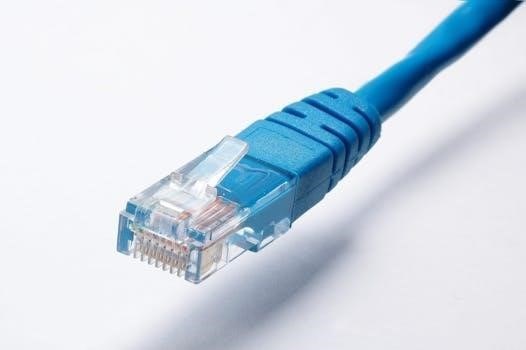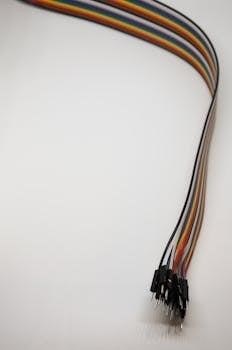Cable guides are essential components for managing and organizing electrical wiring. They ensure a clean, safe, and efficient installation by providing a structured pathway for cables. These guides come in various types and materials.
What are Cable Guides?
Cable guides are physical structures designed to support, direct, and protect electrical and network cables. They facilitate the orderly arrangement of wires, preventing tangles and potential damage. These guides come in various forms, including channels, trays, and clips, catering to different installation needs. They ensure cables are routed neatly, enhancing both safety and aesthetics in residential, commercial, and industrial settings. Cable guides are often made from durable materials, suitable for diverse environments, providing a reliable solution for cable management. The use of cable guides is paramount in maintaining an organized infrastructure.
Types of Electrical Cables
Electrical cables are diverse, designed for specific applications and environments. They include basic power cables, specialized cables for unique conditions, and control cables for automation systems. Each type has distinct characteristics.
Basic Electrical Cables
Basic electrical cables are fundamental for transmitting power and are commonly used in residential and commercial settings. These cables typically consist of conductors, insulation, and a protective outer layer. They are designed to carry electrical current safely and efficiently. Common examples include NM-B cables used in residential wiring for outlets and lighting. Understanding these basic cable types is crucial for any electrical installation, ensuring proper function and safety in various applications.
Special Cables
Special cables are designed for unique applications requiring specific properties beyond standard electrical cables. These include cables for temporary lighting at events, connections for heavy machinery like cranes, and submerged applications in pools or aquariums. These cables are engineered to withstand harsh conditions, varying temperatures, and specific environmental factors. They often feature enhanced insulation, shielding, or flexibility to meet the demands of their specialized use. These special cables ensure reliable power and signal transmission in diverse settings.
Control Cables
Control cables are vital in automation and industrial settings for transmitting signals and controlling equipment. These cables come in various configurations, including CY cables, which feature a tinned copper braid for electromagnetic interference protection. They are flexible for movement without tensile stress, and often used for control systems in industrial machinery and processes. These cables ensure precise and reliable signal transmission to control various devices and automation systems, making them essential for operational efficiency and safety.

Cable Sheathing
Cable sheathing provides protection to the internal conductors. It comes in metallic and non-metallic options, each with specific properties for different applications and environmental conditions.
Metallic Sheathed Cables
Metallic sheathed cables offer robust protection against physical damage and electromagnetic interference. These cables, often encased in materials like aluminum or steel, are suitable for harsh environments. They provide enhanced durability and are commonly used in industrial settings where mechanical stress is a concern. The metallic layer also offers a grounding path and helps in heat dissipation. They are often more expensive than non-metallic options but offer superior protection.
Non-Metallic Sheathed Cables
Non-metallic sheathed cables are a common choice for residential wiring due to their flexibility and ease of installation. Typically, these cables have conductors encased in an insulating polymer. They are lighter and less expensive than metallic options, making them suitable for indoor applications where physical protection is not a major concern. These cables are typically used for general wiring in homes for outlets and lighting. However, they are not suited for environments where there is risk of physical damage.

Network Cables
Network cables are used to connect devices within a network. These include fiber-optic, twisted-pair, and coaxial cables. Each type has unique characteristics that determine its application in data transmission.
Fiber-Optic Cables
Fiber-optic cables transmit data using light signals through thin glass or plastic strands. These cables offer high bandwidth and are less susceptible to interference than traditional copper cables. They are ideal for long-distance communication and high-speed data transfer. Fiber optics are commonly used in telecommunications, internet infrastructure, and data centers. Their ability to carry large amounts of data quickly makes them a crucial component in modern networks, supporting fast and reliable connectivity. The technology relies on light pulses, which result in much faster transmission speeds.
Twisted-Pair Cables
Twisted-pair cables are a common type of network cable that consists of two insulated wires twisted together. This twisting helps to reduce electromagnetic interference and crosstalk, which enhances signal quality. These cables are widely used in Ethernet networks for connecting computers, routers, and other network devices. There are different categories of twisted-pair cables, such as Cat5e, Cat6, and Cat6a, each designed for specific speeds and bandwidth requirements. They are a cost-effective and versatile option for many networking applications and are widely implemented in both residential and commercial settings.
Coaxial Cables
Coaxial cables are another type of network cable that feature a central conductor surrounded by an insulating layer, a conductive shield, and an outer protective jacket. They are commonly used for transmitting television signals and broadband internet connections; Coaxial cables provide good shielding against electromagnetic interference and are capable of carrying high-frequency signals over long distances. While they are less common for modern networking than twisted-pair cables, they still have their place in specific applications such as cable TV and satellite installations. Their robust construction makes them durable and reliable for signal transmission.

Cable Selection Considerations
Selecting the right cable involves carefully considering factors like voltage capacity, the intended application, and the environmental conditions the cable will be exposed to. Proper selection is crucial for safety and performance.
Voltage Capacity
Voltage capacity is a critical consideration when selecting cables, as it dictates the maximum electrical potential a cable can safely handle. Choosing a cable with an inadequate voltage rating can lead to overheating, insulation failure, and potentially dangerous electrical hazards. It’s essential to match the cable’s voltage capacity to the specific requirements of the electrical system it will be part of. Always refer to the manufacturer’s specifications and relevant electrical standards to ensure a safe and reliable installation. Ignoring voltage capacity can compromise safety and system integrity.
Application
The intended application of a cable plays a pivotal role in its selection. Different applications, such as residential wiring, industrial machinery, or network connections, demand specific cable types designed for those environments. Factors like the type of load, the frequency of use, and the presence of any other electrical components, all influence cable selection. Understanding the application ensures the chosen cable can handle the required electrical load, environmental conditions, and performance expectations, guaranteeing safety, reliability, and efficiency. A mismatch can lead to malfunctions or potential hazards.
Environmental Factors
Environmental factors significantly influence cable selection. Cables must be chosen based on their ability to withstand specific conditions. These include temperature fluctuations, moisture exposure, UV radiation, and the presence of chemicals or corrosive substances. Outdoor installations, for example, require cables with robust weatherproofing and UV resistance, while industrial settings might necessitate cables that are resistant to oils or extreme temperatures. Choosing the appropriate cable for the environment ensures the longevity, reliability, and safety of the electrical system, preventing premature wear, damage, or failure. Ignoring these factors can lead to costly repairs and potential hazards.

Cable Identification and Markings
Cable markings are crucial for identifying cable type, size, and specifications. These markings provide essential information for proper installation and maintenance, ensuring safety and compliance with regulations.
Understanding Cable Markings
Cable markings are a standardized system of letters, numbers, and symbols printed directly onto the cable’s sheathing. These markings convey vital information, including the cable’s voltage rating, conductor material, insulation type, and the manufacturer. Understanding these codes is crucial for selecting the correct cable for a specific application and ensuring safe and compliant electrical installations. Markings also help in identifying the cable type for future maintenance or modifications, preventing errors and potential hazards. It is important to consult both national and international standards for accurate interpretation.
Cable Management Solutions
Effective cable management involves various tools and techniques for organizing and securing cables. This includes using guides, ties, clips, and other accessories to maintain a neat and safe environment.
Basic Cable Guides
Basic cable guides are fundamental tools for organizing wires and cables. They offer a simple yet effective way to manage cable pathways, preventing tangles and ensuring a tidy setup. These guides often feature a solid design, with wide channels to accommodate various cable sizes. They include bends for routing cables with connectors, providing a reliable solution for both home and industrial applications, ensuring cables are neatly managed and protected from damage.
Cable Installation
Cable installation requires careful planning and execution, often involving creating accounts, registering the system, and obtaining necessary license keys. Detailed instructions are essential for proper setup and safety.
Installation Instructions
Detailed installation instructions are crucial for a safe and effective cable management system. The process often includes creating a user account, registering the specific system being installed, and acquiring necessary license keys. It’s important to follow these steps precisely to ensure correct cable routing and connectivity. These detailed guidelines help in properly inventorying components and ensuring a smooth installation process, minimizing errors and maximizing the system’s performance according to manufacturer specifications. Proper installation is key for both safety and functionality.
Cable Safety and Regulations
Cable safety is paramount, with regulations ensuring secure installations. Understanding safety considerations and key regulations is critical for preventing electrical hazards and maintaining compliant systems.
Safety Considerations
When working with cables, always prioritize safety. Ensure cables are properly insulated to prevent electrical shocks. Avoid overloading circuits, which can lead to overheating and fires. Always use the correct type of cable for the specific application, considering voltage and environmental factors. Proper installation techniques are crucial; never cut or damage the cable sheathing during the process. Regular inspections can help identify potential issues before they become hazardous. Adhering to safety guidelines is essential for preventing accidents and ensuring a safe environment.
Key Regulations
Adhering to key regulations is paramount when dealing with electrical cables. National and international standards dictate specific requirements for cable types, installation, and safety. These regulations ensure that cables are suitable for their intended use and prevent electrical hazards. Compliance with the National Electrical Code (NEC) or equivalent local standards is a must. Regulations also cover the proper identification, markings, and voltage capacity of cables. Staying updated on these regulations is essential for safe and compliant electrical installations. Ignoring these rules can result in severe consequences.
